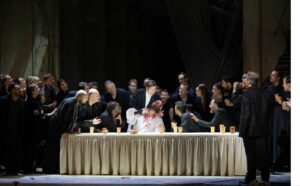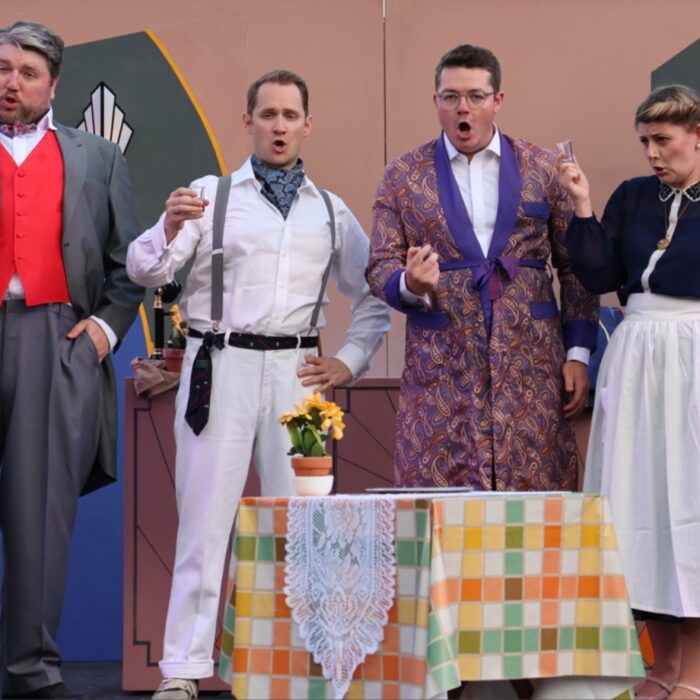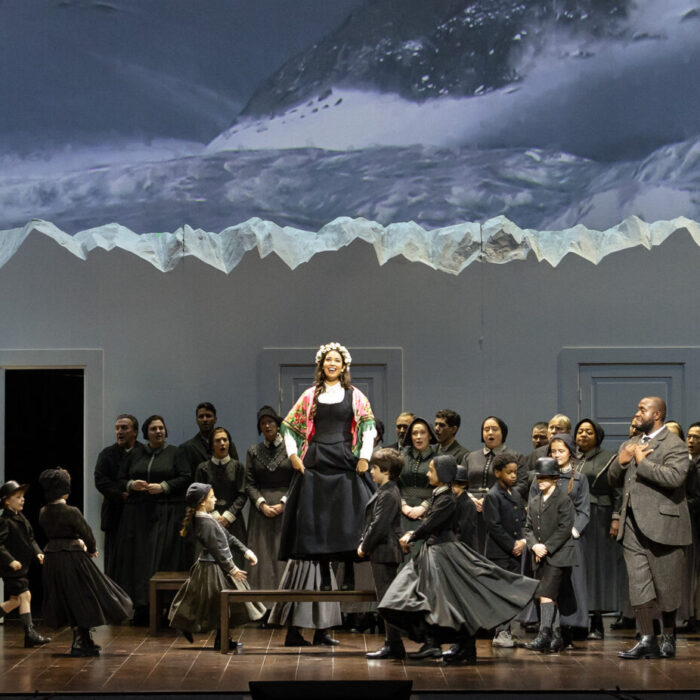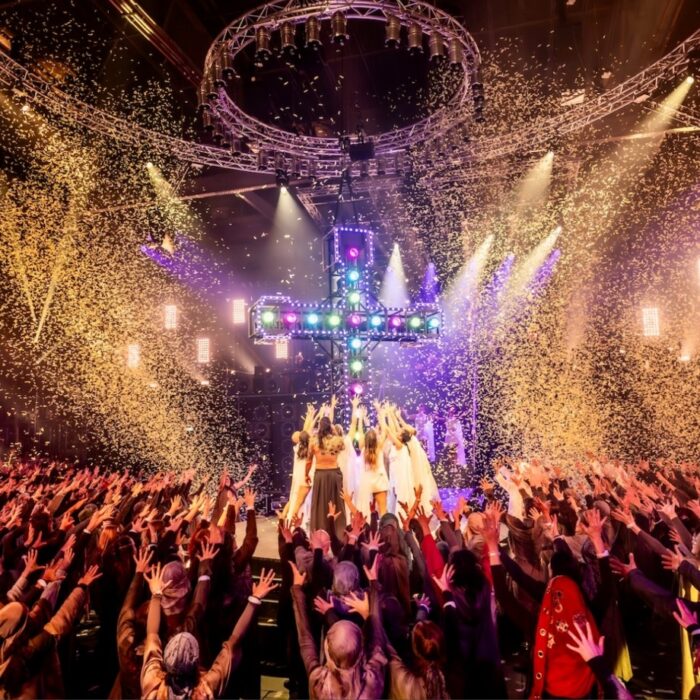
Festival d’Aix-en-Provence 2024 Review: Samson
Pichon & Gluth Reimagine Rameau with a Stellar Cast Including Jacquelyn Stucker’s Unforgettable Performance
By João Marcos Copertino(Photo credit: Monika Rittershaus)
“So, who is signing the work?” an operagoer asks Raphaël Pichon and Claus Guth at a lunchtime panel about their opera-project “Samson.” The music is Rameau’s, but it is not that simple. According to Guth (and his Wikipedia search), Rameau did indeed compose a “Samson” with a libretto by Voltaire; however, it is all lost. Pichon and Guth’s idea was to create a show, with Rameau’s music from elsewhere, and with lyrics either by Voltaire or sounding like Voltaire. It is “Samson” after French composer Jean-Philippe Rameau—but I would add: curated by Pichon and Guth. However one judges the accuracy of the reconstruction, musically, the opera works superbly—and it is good theater.
We are all mostly well-informed about the final chapter of Samson’s history: his torrid affair with Dalila and his destruction of the temple. Guth decided to begin the opera earlier than that, accentuating the similarity of Samson’s journey to that of Jesus. The first thing we see as the opera opens is an actress playing Samson’s mother. She wanders by the ruins of a house while remembering her dead son—whose coming was also announced by an angel. After that we are given a chronological presentation of Samson’s story: beginning not with Dalila, but with his first doomed marriage to a Philistine woman, here named Timna. The action is static when the music is playing. Samson’s bursts of strength are represented by fragments from the Bible projected on the stage, saving the audience from having to see him rip apart a lion or setting the tails of foxes on fire and loosening them upon the Philistine fields.
The actual conflict of Samson seems to be less about Jews against Philistines, or lust against vocation, and more about an ambivalent representation of good and bad. Samson, as all Israel, is dressed in white, while the Philistines are in black. We get it, they are bad, but their wickedness does not make Samson less problematic. The women (Timna and later Dalila) and Elon are dressed both in black and white. They, perhaps, suffer as much as our hero does. They are tortured, harassed, and murdered by the Philistine leader.
That said, the staging, though beautiful, is not out of incoherences. Some characters are very hard to explain (especially Elon), and the differences between the two Philistine women is less nuanced than one would like. Is Timna more conciliatory and Dalila more instrumental? I could not tell. And how do these women work in the process of seduction and desire? Why does Samson love them specifically? Still, while Guth might have little to say about desire and affection, his construction of the hero’s journey through Christian imagery is laudable: his placement of a blinded Samson at a table that recalls the last supper; an ascending angel announcing Samson’s birth in the midst of ruins; the entrances of the glamorous Timna and Dalila.
Another essential aspect of the production is the amazing work done with the lighting by Bertrand Couderc. In the austere times that we live in, most new stagings use solely one scenario for all five acts of an opera. Most of the time, this solution only accentuates the emptiness of theater managers’ pockets and minds. In this case, however, Couderc’s lighting made all the difference, exploiting to exhaustion the beauty of the ruined scenario designed by Étienne Pluss. From the warm yellow lights of the annunciation to the cold, opaque, blue tonalities in Timna’s final aria, it was poetry for the eyes.
Miraculous Musical Moments
But if in this Frankenstein’s creature of an opera, the staging was beautiful, I cannot mince words about the musical quality of the show. Few people know and understand Rameau better than Raphaël Pichon—that is beyond question. His selection of Rameau arias is impeccable. The fact that no one knew what music was coming next only enhanced the surprise effect of the drama. Each aria was a discovery, and they always enhanced the drama. Beyond that, Pichon, when conducting his Pygmalion orchestra and chorus, seems to understand extremely well the technicalities of performing opera. His orchestra, rightfully, transits most of the night between pianissimo and mezzo piano—with only a few fortes—, allowing the audience to hear the beauty of the singers’ voices without competition from the pit. Moreover, the addition of electronic sounds by Mathis Nitschke, though certainly disruptive, was never too loud in relation to the acoustic singers. Somehow, it seemed that they all inhabited the same sonic universe.
Jarrett Ott was a tender and tormented Samson. Instead of being a beacon of masculinity, his Samson had something of juvenile ingenuousness that made the character extremely difficult to understand. How could such a sweet figure, one was led to ask, erupt in such vicious ways? His singing was better than ever, with just a bit of difficulty in the low notes. His French was more than proper; Ott is an actor and singer in continuous evolution. His voice is progressively more sonorous. Perhaps the major appeal of his acting is precisely its capacity of conveying a kind, strong man. His face and his gestures are more congenial than aggressive, a rare feature in any medium nowadays.
Nevertheless, I ought to say that the brightest stars of the night were the two women: Lea Desandre and Jacquelyn Stucker, Timna and Dalila, respectively.
Few mezzo-sopranos have a voice as beautiful as Lea Desandre’s. Her tone is extraordinarily youthful, and her devotion to acting enables her to have immense dramatical flexibility without ever compromising her vocal performance. It is hard not to be compelled by her phrasing and sublime high notes in ringing pianissimo during the first and second acts of the opera. Her “Tu chantais” (originally from “Les Fêtes d’Hebé”) rang in my mind as the definition of beauty in musical form. Her final aria was even more impressive, sung with her merely sitting on the rocks of the scenario, a melancholic manifesto of female disgrace.
To follow up Desandre’s appearance in the first half of the opera was a hard task; still, Jacquelyn Stucker was phenomenal. I will not mince words. Her Dalila, again, more tragic than an occasion for erotic turmoil, was unforgettable. Guth demanded much from his vocalists in physical terms, but I dare say Stucker was the one who was most exposed on the stage. She sang most of the opera in her underwear, being humiliated and despised by the philistines in the most aggressive manner. All this vulnerability translated into some of the most exquisite singing—perhaps of a lifetime. Her rendition of “Viens, hymen” (from “Les Indes Galantes”), which displayed the high quality of her phrasing, musically served to establish the parallelism linking her character to Desandre’s Timna. Her voice sounded pure, lyrical, and warm.
Nevertheless, it was when she sang “Tristes apprêts, pâles flambeaux” (from “Castor et Pollux”) that I felt my existence had been transformed into something else. Although I have been privileged to see many great musical performances, I can count on my fingers the times I have felt I witnessed a life-changing musical event. They have all been live performances, heard with my fleshy ears. I carry their names inscribed in my heart—and on a Google doc. I will not reveal the entire list, but yesterday, just after Krystian Zimerman’s Chopin’s B-minor Sonata (Amsterdam) and Sabine Devieilhe’s Lakmé (Paris), I had to write: Jacquelyn Stucker’s “Tristes apprêts” (Aix-en-Provence).
It was the perfect storm—quite literally. There was light rain for most of the second part of the opera, soaking my Moleskine and concert program. But it was impossible to stop the performance. Stucker’s high notes were in pure pianissimo and still perfectly audible, in an open-air theater! The orchestra blended so well that it was impossible to distinguish the instruments’ textures from each other—they emulated an unknown pulsating force of nature. In the da capo, I wished time lasted longer—Did not the Lord cease the movement of the earth for Joshua? Why not do it again? Back home, I listened to all the recordings of the aria that I could find on streaming medias—they were all good, and some even great—, but nothing was as extraordinary as Stucker’s in Aix.
More Cast Highlights
The female trio was completed by the charming Julie Roset. For those who have not seen her in Operalia, it is hopeless to try to explain the beauty of her voice. Her coloratura, though not yet seamless, is as angelical as it is said to be. Her first appearance, as she was lifted in the middle of the stage, singing “Ah! Que votre sort est charmant” (from “Dardanus”), was ethereal.
The Philistine villain, Achisch, was performed by the excellent Nahuel di Pierro. The wickedness of the character seemed most unjustified or unjustifiable—he was bad just because. However, his voice was well-projected and his sadism palpable.
Laurence Kilsby sang Elon, a dramaturgically confusing character. Despite Kilsby’s evident artistic development (every time I hear him, he is more and more in his element), his character seemed to serve the music more than the drama. He is written as Timna’s best friend—which is in no way evident in the mis-en-scene. He is dressed in black and white, as if he were a converted Jew? I could not tell. Still, his vocal performance was refreshing.
“Samson” after Rameau is a compelling piece of drama, and an extraordinary séance of music. Its success derrives from a strong cast—especially in the female voices—and an exhuberant musical direction. Mark my words: Raphaël Pichon conducting his Pygmalion is always a musical event not to be missed. Claus Guth makes a compelling theatrical event out of this charmingly hybrid opera. Nevertheless, besides the exquisite music and charming drama, it is hard to understand the message behind this “Samson.” Perhaps it is just about the contextualization and drama—with musical performances and visuals that are good, who am I to complain? The issue is that such creative work seems to be driven more by the aesthetics of the hero’s journey than by anything else. In that regard, despite the great work done by the writing team, the result is very contemporary, shifting away from Voltaire’s philosophical programs and even from Enlightenment itself.
Certainly a night that I will not let myself forget, this “Samson” works because of Rameau’s music, but not only that. There is little effort to reconstruct the past; it is a journey of resignification, questioning the centrality of the composer, while also denying the supremacy of the regietheater. Staged somewhere else, this “Samson” could survive having some arias replaced by others. It is not a fixed work. And its beauty lies precisely there. Wandering in the air of the night, “Samson’s” music, while always well-known, resounded as new— and now, somehow, seems forever gone. Only the memory of it will last.


